By
De Bassi - Arturo De Bassi, his story and an interview of 1937.

ianist, he was as well clarinetist like his father, Cayetano De Bassi. Arturo was born in the Buenos Aires neighborhood of La Recoleta on April 24, 1890 and died of a heart attack in this city on June 18, 1950.
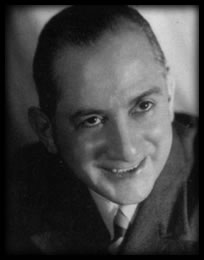 Connected to the theater and the musical world of the city since early age and, consequently to success, we can verify that his first composition filed in the copyright public registry was given the number 505 in 1911. He filed that day a number that would bring to him great satisfactions: “La catrera”, like many others also would.
Connected to the theater and the musical world of the city since early age and, consequently to success, we can verify that his first composition filed in the copyright public registry was given the number 505 in 1911. He filed that day a number that would bring to him great satisfactions: “La catrera”, like many others also would.
To have an idea of the esteem by which he was regarded, let us remember that Alfredo Améndola, owner of the Atlanta label, entrusted him with the leadership of his rondalla with which he recorded 100 numbers, and of his band. He cut 73 matrixes under his responsibility.
He was 26 years old when he had already recorded 38 numbers, what gives us an idea of his activity.
As musician he contributed to many theater plays for which he had to write the music score. He was specialized in sainetes and revues. His elder brother, Antonio, comedy writer and author of some tango lyrics, was not alien to this task.
He carried out activities in the union and enterprise fields. They quit the Sociedad Argentina de Autores to join the Círculo de Autores y Compositores in the middle of a conflict between actors and entrepreneurs in 1921. Then they withdrew their repertoire from the former. Because of that an important newspaper of our city wrote: «What a pity! Facing so much misfortune there is no other resource but imploring the De Bassis not to leave for the sake of lyrical art, of musicians, of choirs and the children of the choir members». They heard nothing but their interests.
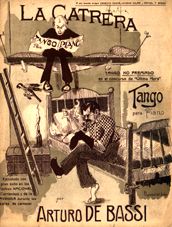 Arturo De Bassi, after a period in which he was absent from musical activities, put together his own tango orchestra in 1942 and played on Radio Splendid. Those were other times, other tastes, other airs.
Arturo De Bassi, after a period in which he was absent from musical activities, put together his own tango orchestra in 1942 and played on Radio Splendid. Those were other times, other tastes, other airs.
In his career the pieces of his repertoire that stood out because they went beyond their time of creation, their period, were “El caburé”, “La catrera” and “El incendio”.
We transcribe below an interview published in the Radiolandia magazine on October 2, 1937.
«Arturo De Bassi is beyond introductions. Or better saying, he ought to be. Because of his mission accomplished, because of the fruits of his creation, for what he meant for the history of the popular music of Buenos Aires. Because of that and much more that the present generations in touch with passing idols forgot or are completely unaware. For them, who do not know the capacity of this life, we make this interview. And also as a proper remembering dedicated to those that always appreciate and ponder him in the exact value he deserves.
«Believe me, my friend, —says De Bassi— that I generally prefer not to speak of yesterday’s things. A little out of coquetry… d’you know? People think that I’m older than Methuselah!»
«—And the other little bit?»
«—The other little bit, out of respect. They say so many things about the near past. A fable is made up. So many opinions are brought! To be silent in the middle of this game of opinions equals to respect.»
«—Tell us about yourself, pal De Bassi. Won’t you?»
«—I don’t think it interesting...»
«—That’s up to me...»
«—Stop it with that of responsibility...»
«—Which was your neighborhood?»
«—The North side. More precisely, we were born in the north but we were raised in the south, around Balvanera. My father was a musician. And all his children studied music. But professionally three of us devoted to it, Antonio, Tomás and I. I, specially, because I always had a stronger inclination.»
«—Which was your professional beginning?»
«—At the Apolo theater as member of the orchestra led by maestro Antonio Reynoso. It was the orchestra of the zarzuela company comprised by Pepe, Antonio and Pablo Podestá, Lea Conti, Olinda Bozán, Herminia Mancini and the three Borda sisters. I was a thirteen year-old kid! I was stepping into life with amazement in my eyes. Everything was wonderful for me, how shouldn't it be! I was part of the opening of Los Disfrazados, a wonderful lyrical one-act farce by Pacheco. And as well in Las Empanadas by Soria and Payá.
«—What do you remember of that year with greatest affection?»
«—It was 1906. I was almost a child. One day my inspiration brought me as a gift a tango conceived on the firemen's sounds. Named “El incendio” (The Fire), it was premiered at the Apolo itself during an intermission. Tango had not yet reached the family environment, however, mine surpassed unimaginable levels of popularity.»
«—Who was its publisher?»
«—I myself. I paid the copies to Ortelli y Hermanos and with them under my arm I visited all the music shops to leave the music piece on consignment. I even sold 50.000 copies. Imagine how it could be since every week I returned to the shops where I had left the music sheets and came back home with three or four "canarios" (banknotes) in my pocket.»
"—Did you keep on composing?"
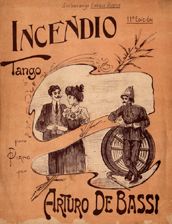 «—I did. So were born "El auxilio" with the whistle of the chaferola, "El recluta" with the army bugles. Four years had elapsed since that. I was already popular. I warn you -says De Bassi with an intelligent accent- that now I understand what popularity means. Let's go on: Última Hora had organized a tango contest, the first contest. Do you realize what that meant for us? I enrolled with the tango “La catrera”, but it was a failure unfortunately. It was not even nominated. Angry, with that impulse of young age -eighteen-, I published it with the following writing: «Tango not awarded at the Última Hora contest». It was an extraordinary hit. For twenty years it was indefatigably sold. It was played everywhere.»
«—I did. So were born "El auxilio" with the whistle of the chaferola, "El recluta" with the army bugles. Four years had elapsed since that. I was already popular. I warn you -says De Bassi with an intelligent accent- that now I understand what popularity means. Let's go on: Última Hora had organized a tango contest, the first contest. Do you realize what that meant for us? I enrolled with the tango “La catrera”, but it was a failure unfortunately. It was not even nominated. Angry, with that impulse of young age -eighteen-, I published it with the following writing: «Tango not awarded at the Última Hora contest». It was an extraordinary hit. For twenty years it was indefatigably sold. It was played everywhere.»
«—Up to when did the writing continue?»
«—Until recently, when I reissued it, I took out the revengeful phrase. My youth had already passed. Furthermore I had already avenged myself during a long time.»
«—What composer was awarded the first prize?»
«—A good composer. His name was Eduardo Bolter Bulterini. See how things are! Three months ago I came to know him. When he was introduced to me he became very happy. He told me he was the first admirer of “La catrera”. According to him my tango was the summit of Buenos Aires dance music. What noble satisfactions life brings to us!»
«—Please go on with the series of your triumphs.»
«—In 1911 I wrote one of the tangos I love most: “El Caburé”. It is inspired in a phrase of mine that belongs to a play with the same name. Do you remember? "Me llaman caburé, caburé porque soy ..." (They call me caburé, caburé because I am ...»
«—How should I not remember! Which is the origin of tango according to you?»
«—For me the origin of tango is habanera. In the early days tango had the beat of habanera. Now it has changed. But its origin was that. If you analyze “La morocha” you become aware of its origin.»
«—How many periods of tango do you know?»v
«—Tango has three periods. The first, the heroic epoch; I didn't know it. I came to life when it was ending. It was the time when there were private balls in Buenos Aires to which the well-to-do boys went to have fun behind the shadow of a secret. It was when dancing was a hidden activity. It was the time of Manuel Campoamor, Ángel Villoldo, Rosendo Mendizábal, Alfredo Bevilacqua, El Pibe Ernesto Ponzio, Juan Carlos Bazán, Roberto Firpo, Luis Chiappe Ducca, Ernesto Tornquist. When tango was an activity of the underworld and was danced popularly on the street corners to the music of the barrel-organs and there were dances among boys wearing Masera little hats, as “Milonga del novecientos” says.»
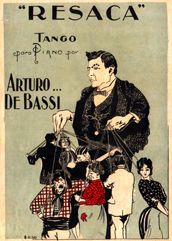 «The second period started when I appeared in popular music. Then tango was accepted but as a strange thing. We played it, as I told you, at the Apolo, but it was not accepted at family houses. That happened when it came back from Paris. Tango entered venues by chance. There was a genre more frequented than tango: milonga.»
«The second period started when I appeared in popular music. Then tango was accepted but as a strange thing. We played it, as I told you, at the Apolo, but it was not accepted at family houses. That happened when it came back from Paris. Tango entered venues by chance. There was a genre more frequented than tango: milonga.»
«The third period corresponds to the tango as a song. The dance weakens and song becomes richer. Now we are on a trip back to the past. There are interesting symptoms. This return is presided by Canaro with his orchestra, which keeps a national personality. It is strengthened by composers new in age but old in style and soul. The resurrection of milonga due to the best players of the time, the authors of “Milonga sentimental” is another symptom.»
«The first tango that was danced on stage to great acclaim was at the play La beata. The central characters were impersonated by two «monsters», Pablo Podestá and Orfila Rico. He was in the role of a bully and she was starred as an old woman of a tenement house. The kid taught the old woman how to dance a tango. They did it wonderfully. A phrase by Pablo became a popular saying: «Move what I told you». The tango belonged to Antonio Podestá.»
«—Were the tango tunes sung?»
«—They were sung at the vaudeville.»
«—Who sang then?»
«—The queens were Linda Thelma and Pepita Avellaneda. The most popular tangos were “La morocha” and “Pica, pica”.»
«—Did you write music for zarzuelas?»
«—Several ones.»
«—Did you include tangos in the music of the plays?»
«—Not tangos precisely. I took advantage of the tango and the milonga rhythms to add a criollo color.»
«In El rincón de los caranchos, with script by Novión, Esther Podestá used to sing a tango of mine. And in another play by Bayón Herrera, César Ratti sang another tango, do you see?»
«—Did all the actors sing?»
«—Nearly all of them. Even Ada Comaro, I recall having heard her sing at a scene. So I can also name Pablo Podestá —creator of the estilo that was played at La piedra del escándalo—, Pepe Podestá, Olinda Bozán, Segundo Pomar, Vittone, Florencio Parravicini, César Ratti, Alberto Ballerini, Nava, Lea Conti, Manolita Poli, Salvador Rosich. There was an actor, Robledo, who because of the guys he impersonated, had specialized in singing tangos.»
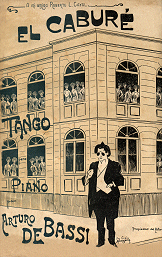 «By that time theater provided the opportunity for the great composers to be inspired. Forgotten, unjustly forgotten. Antonio Reynoso was the greatest thing that criollo theater produced. He was Basque but he had a Buenos Aires flavor that no one has surpassed. He had a great knowledge and a strong inspiration. He visited neighborhoods and cheap cafés. There he captured themes -which he wrote on his shirt's cuffs-, that he developed with exemplary precision. The sextet of Los disfrazados is a piece of the soul of Buenos Aires.»
«By that time theater provided the opportunity for the great composers to be inspired. Forgotten, unjustly forgotten. Antonio Reynoso was the greatest thing that criollo theater produced. He was Basque but he had a Buenos Aires flavor that no one has surpassed. He had a great knowledge and a strong inspiration. He visited neighborhoods and cheap cafés. There he captured themes -which he wrote on his shirt's cuffs-, that he developed with exemplary precision. The sextet of Los disfrazados is a piece of the soul of Buenos Aires.»
«—Were there others?»
«—García Lalane was another serious case. In Ensalada criolla, a revue of the time, he has the duo of "Gabino, el mayoral", that is a generous page of the criollo songbook. And like them Payá, Chelli, Miquez, and Carrilero were, and modestly, I was as well.»
«In my times people used to think that in order to write tango music you had to be tough guy. The composer was thought of as a long-haired man with pony-tail and military heels. When I was introduced to someone they were reluctant to believe that I was the composer of “El caburé” or “La catrera”. Once when I sat at a table of the diner of the fast train to Rosario, my three occasional table companions were talking about tango. Unexpectedly “La catrera” came into spotlight. One of them said he knew its author. And he described me in rough strokes. «He is a pure criollo, said he, he has enormous moustaches and he always carries a large knife in his belt».»
«In my opinion, tango triumphed worldwide for two reasons. Firstly, because as a dance it allows a lulling intimacy between the dancers. It's a dance made for "love talk". Secondly, because of its lyrics. The problem of unrequited love happens everywhere. Because of that in every place you'll find hearts ready to be charmed by the drama of tango.»
«—Which is your greatest desire now?»
«—To be able to reminisce through radio all the music of the Buenos Aires theater, to show to this new Buenos Aires the things of the old city when there were not skyscrapers and the soul of the orb had a definition belonging to the River Plate, when foreign influence was not yet the master of the people, when the best was ours. When we, the artists, worked on the native soul with the love of the sculptor that carves an idea on the wood of the tree which was born beside him. When the porteño spirit had a clear meaning. When we struggled to embellish reality. And to show it to the present generations as homage to those creators and also as a piece of evidence to show that what it is criollo has a respectable history. And to give this lesson with the easiest understandable language: music.»